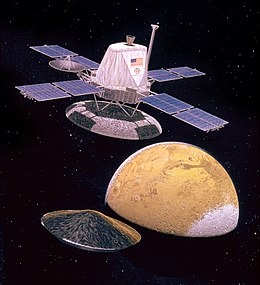
Back Viking-program Afrikaans برنامج فايكينغ Arabic Vikinq proqramı Azerbaijani وایکینگ برنامهسی AZB Праграма «Вікінг» Byelorussian Викинг (програма) Bulgarian ভাইকিং প্রোগ্রাম Bengali/Bangla Program "Viking" BS Programa Viking Catalan Program Viking Czech
 Artist impression of a Viking orbiter releasing a lander descent capsule | |
| Manufacturer | Jet Propulsion Laboratory / Martin Marietta |
|---|---|
| Country of origin | United States |
| Operator | NASA / JPL |
| Applications | Mars orbiter/lander |
| Specifications | |
| Launch mass | 3,527 kilograms (7,776 lb) |
| Power | Orbiters: 620 watts (solar array) Lander: 70 watts (two RTG units) |
| Regime | Areocentric |
| Design life | Orbiters: 4 years at Mars Landers: 4–6 years at Mars |
| Production | |
| Status | Retired |
| Built | 2 |
| Launched | 2 |
| Retired | Viking 1 orbiter August 17, 1980[1] Viking 1 lander July 20, 1976[1] (landing) to November 13, 1982[1] Viking 2 orbiter July 25, 1978[1] Viking 2 lander September 3, 1976[1] (landing) to April 11, 1980[1] |
| Maiden launch | Viking 1 August 20, 1975[1][2] |
| Last launch | Viking 2 September 9, 1975[1][3] |
The Viking program consisted of a pair of identical American space probes, Viking 1 and Viking 2, which landed on Mars in 1976.[1] The mission effort began in 1968 and was managed by the NASA Langley Research Center.[4] Each spacecraft was composed of two main parts: an orbiter designed to photograph the surface of Mars from orbit, and a lander designed to study the planet from the surface. The orbiters also served as communication relays for the landers once they touched down.
The Viking program grew from NASA's earlier, even more ambitious, Voyager Mars program, which was not related to the successful Voyager deep space probes of the late 1970s. Viking 1 was launched on August 20, 1975, and the second craft, Viking 2, was launched on September 9, 1975, both riding atop Titan IIIE rockets with Centaur upper stages. Viking 1 entered Mars orbit on June 19, 1976, with Viking 2 following on August 7.
After orbiting Mars for more than a month and returning images used for landing site selection, the orbiters and landers detached; the landers then entered the Martian atmosphere and soft-landed at the sites that had been chosen. The Viking 1 lander touched down on the surface of Mars on July 20, 1976, more than two weeks before Viking 2's arrival in orbit. Viking 2 then successfully soft-landed on September 3. The orbiters continued imaging and performing other scientific operations from orbit while the landers deployed instruments on the surface.
The project cost was roughly US$1 billion at the time of launch,[5][6] equivalent to about $6 billion in 2023 dollars.[7] The mission was considered successful and is credited with helping to form most of the body of knowledge about Mars through the late 1990s and early 2000s.[8][9]
- ^ a b c d e f g h i Williams, David R. Dr. (December 18, 2006). "Viking Mission to Mars". NASA. Archived from the original on December 6, 2023. Retrieved February 2, 2014.
- ^ Nelson, Jon. "Viking 1". JPL. Archived from the original on October 24, 2023. Retrieved February 2, 2014.
- ^ Nelson, Jon. "Viking 2". JPL. Archived from the original on October 8, 2023. Retrieved February 2, 2014.
- ^ Soffen, G. A. (July–August 1978). "Mars and the Remarkable Viking Results." Journal of Spacecraft and Rockets. 15 (4): 193-200.
- ^ Cite error: The named reference
nssdc-viking1orbiterwas invoked but never defined (see the help page). - ^ Howell, Elizabeth (October 26, 2012). "Viking 1: First U.S. Lander on Mars". Space.com. Archived from the original on September 6, 2023. Retrieved December 13, 2016.
- ^ Johnston, Louis; Williamson, Samuel H. (2023). "What Was the U.S. GDP Then?". MeasuringWorth. Retrieved November 30, 2023. United States Gross Domestic Product deflator figures follow the MeasuringWorth series.
- ^ "The Viking Program". The Center for Planetary Science. Archived from the original on November 20, 2023. Retrieved April 13, 2018.
- ^ "Viking Lander". California Science Center. July 3, 2014. Archived from the original on May 27, 2023. Retrieved April 13, 2018.